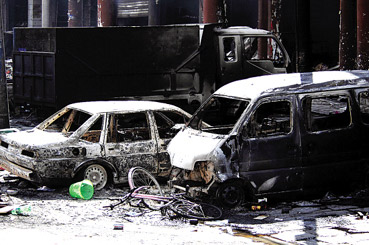Dalai clique's masterminding of Lhasa violence exposed
Updated: 2008-03-30 15:47
They claimed that the movement is a "turning point on the history of Tibetan's struggle for freedom," the article said.
"They divided the movement into four stages," it said. The first was to recruit participants and promote the ideas of the movement. The second stage, or the action step, started on March 10, followed by the third one to organizing demonstrations across the world. The last one was to launch actions in the regions inhabited by Tibetan people inside China.
FOREIGN ASSISTANCE
On February 15 to 17, the five organizations launched training programs on persons in charge of the movement activities in Dharamsala in northwest India, where the "Tibetan government-in-exile" was located. Four days later, they started a six-day campaign to recruit participants in the same place.
 Vehicles are burnt down by rioters in Lhasa. [Tibet Daily] more photos |
The "GCSMT" obtained financial assistance from the U.S.-based National Endowment for Democracy (NED) on February 27 as the fund "for activists to deal with dangers."
According to the NED report, the foundation had granted 1.36 million U.S. dollars to the Dalai clique between 2002 and 2006. In 2006 alone, it gave 85,000 dollars to the organizations such as the "TWA" and "GCSMT."
On March 10, after careful selection, 101 hard-core members set off from Dharamsala to undrape the movement.
HISTORY REPEATS ITSELF
March 10 is the anniversary of the so-called "Tibet uprising" in 1959. On the day 49 years ago, Lhasa had seen a bloody riot initiated by the Dalai clique. Rioters killed Pagbalha Soinam Gyamco, senior lama and a member of the preparation committee of the Tibet Autonomous Region, tied his body with a horse and dragged it for two kilometers.
The day, annually remembered by the Dalai clique, was a remembrance of violence. And history seemed to repeat.
The same day this year, a ceremony was held in Dharamsala to mark the event and the 14th Dalai Lama criticized in a statement that the Chinese government imposed "more severe repression upon Tibetans in Tibet", "trampled on human rights and limited religious freedom" while appreciating "Tibetan people's sincerity, courage and resolution."
Right after the ceremony, about 300 monks from Zhaibung Monastery tried to march into Lhasa downtown, and in the following days, monks from other temples in Lhasa also tried to demonstrate but were held back by police.
When the monks' efforts to spread unrest failed, violent rioters came. They torched shops and vehicles, attacked innocent passers-by on the streets and even ambulances on March 14.
TRYING TO ESCAPE RESPONSIBILITY
After the Lhasa riot on March 14, which is so far known to have claimed at least 18 civilian lives and caused 382 injuries, unrest erupted in other Tibetan-inhabited regions in the southern part of Gansu Province and the northern part of Sichuan Province.
Mobs, some shouting slogans for "Tibet independence" and bearing flags of the so-called "Tibetan government-in-exile", stormed into and attacked government offices, police stations, hospitals, schools and banks.
Moreover, the backers of the Dalai Lama spread violence even further by organizing rioters to attack Chinese embassies and consulates in the United States, Canada, India, Britain, France, Germany, Belgium, the Netherlands, Switzerland and Australia, the article said.
|
||
|
||
|
|
|
|











